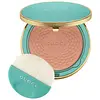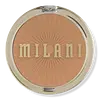What's inside
What's inside
 Key Ingredients
Key Ingredients

 Benefits
Benefits

 Concerns
Concerns

 Ingredients Side-by-side
Ingredients Side-by-side

Synthetic Fluorphlogopite
C30-45 Alkyl Dimethicone
Skin ConditioningSilica
AbrasiveButyrospermum Parkii Butter
Skin ConditioningSorbitan Isostearate
EmulsifyingC20-24 Alkyl Dimethicone
Skin ConditioningCaprylyl Glycol
EmollientEthylhexylglycerin
Skin ConditioningParfum
MaskingPolymethylsilsesquioxane
C20-24 Olefin
Skin ConditioningDiethylhexyl Syringylidenemalonate
Skin ProtectingRicinus Communis Seed Oil
MaskingSodium Hyaluronate
HumectantAlumina
AbrasiveLimonene
PerfumingCaprylic/Capric Triglyceride
MaskingHydrogenated Castor Oil
EmollientLinalool
PerfumingGlycerin
HumectantZinc Stearate
Cosmetic ColorantBenzyl Salicylate
PerfumingCitronellol
PerfumingGeraniol
PerfumingCitral
PerfumingMica
Cosmetic ColorantCitric Acid
BufferingTin Oxide
AbrasiveIron Oxides
CI 77891
Cosmetic ColorantSynthetic Fluorphlogopite, C30-45 Alkyl Dimethicone, Silica, Butyrospermum Parkii Butter, Sorbitan Isostearate, C20-24 Alkyl Dimethicone, Caprylyl Glycol, Ethylhexylglycerin, Parfum, Polymethylsilsesquioxane, C20-24 Olefin, Diethylhexyl Syringylidenemalonate, Ricinus Communis Seed Oil, Sodium Hyaluronate, Alumina, Limonene, Caprylic/Capric Triglyceride, Hydrogenated Castor Oil, Linalool, Glycerin, Zinc Stearate, Benzyl Salicylate, Citronellol, Geraniol, Citral, Mica, Citric Acid, Tin Oxide, Iron Oxides, CI 77891
Talc
AbrasiveZea Mays Starch
AbsorbentZinc Stearate
Cosmetic ColorantDimethicone
EmollientMica
Cosmetic ColorantPentaerythrityl Tetraisostearate
EmollientOctyldodecyl Stearoyl Stearate
EmollientCaprylyl Glycol
EmollientSilica
AbrasiveHdi/Trimethylol Hexyllactone Crosspolymer
Nylon-12
Hexylene Glycol
EmulsifyingArgania Spinosa Kernel Oil
EmollientDiisostearyl Malate
EmollientLauroyl Lysine
Skin ConditioningCocos Nucifera Oil
MaskingGardenia Taitensis Flower
Skin ConditioningTocopherol
AntioxidantPhenoxyethanol
PreservativePotassium Sorbate
PreservativeAroma
CI 15850
Cosmetic ColorantCI 19140
Cosmetic ColorantIron Oxides
CI 77742
Cosmetic ColorantCI 77891
Cosmetic ColorantTalc, Zea Mays Starch, Zinc Stearate, Dimethicone, Mica, Pentaerythrityl Tetraisostearate, Octyldodecyl Stearoyl Stearate, Caprylyl Glycol, Silica, Hdi/Trimethylol Hexyllactone Crosspolymer, Nylon-12, Hexylene Glycol, Argania Spinosa Kernel Oil, Diisostearyl Malate, Lauroyl Lysine, Cocos Nucifera Oil, Gardenia Taitensis Flower, Tocopherol, Phenoxyethanol, Potassium Sorbate, Aroma, CI 15850, CI 19140, Iron Oxides, CI 77742, CI 77891
Ingredients Explained
These ingredients are found in both products.
Ingredients higher up in an ingredient list are typically present in a larger amount.
Caprylyl Glycol is a humectant and emollient, meaning it attracts and preserves moisture.
It is a common ingredient in many products, especially those designed to hydrate skin. The primary benefits are retaining moisture, skin softening, and promoting a healthy skin barrier.
Though Caprylyl Glycol is an alcohol derived from fatty acids, it is not the kind that can dry out skin.
This ingredient is also used as a preservative to extend the life of products. It has slight antimicrobial properties.
Learn more about Caprylyl GlycolCi 77891 is a white pigment from Titanium dioxide. It is naturally found in minerals such as rutile and ilmenite.
It's main function is to add a white color to cosmetics. It can also be mixed with other colors to create different shades.
Ci 77891 is commonly found in sunscreens due to its ability to block UV rays.
Learn more about CI 77891Mica is a naturally occurring mineral used to add shimmer and color in cosmetics. It can also help improve the texture of a product or give it an opaque, white/silver color.
Serecite is the name for very fine but ragged grains of mica.
This ingredient is often coated with metal oxides like titanium dioxide. Trace amounts of heavy metals may be found in mica, but these metals are not harmful in our personal products.
Mica has been used since prehistoric times throughout the world. Ancient Egyptian, Indian, Greek, Roman, Aztec, and Chinese civilizations have used mica.
Learn more about MicaSilica, also known as silicon dioxide, is a naturally occurring mineral. It is used as a fine, spherical, and porous powder in cosmetics.
Though it has exfoliant properties, the function of silica varies depending on the product.
The unique structure of silica enhances the spreadability and adds smoothness, making it a great texture enhancer.
It is also used as an active carrier, emulsifier, and mattifier due to its ability to absorb excess oil.
In some products, tiny microneedles called spicules are made from silica or hydrolyzed sponge. When you rub them in, they lightly polish away dead skin layers and enhance the penetration of active ingredients.
Learn more about SilicaZinc Stearate is the metal salt of stearic acid. It is a white solid used to bind, thicken, and lubricate products.
This ingredient is common in powder makeup, where it helps keep the powder together.
Zinc Stearate is hydrophobic and repels water.
This ingredient can be sourced from non-animal or animal sources. It is best to reach out to the brand to see where they source this ingredient from.
Learn more about Zinc StearateThis ingredient is a combination of red, black, and yellow iron oxide pigments. This combination of colors is usually found in foundation, because it results in a "skin" color.